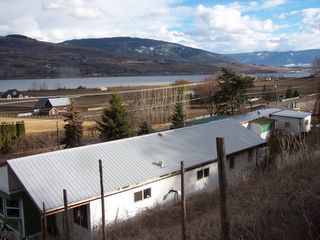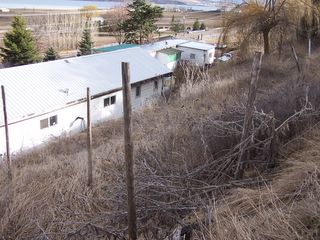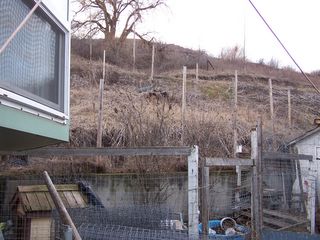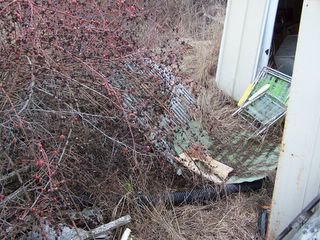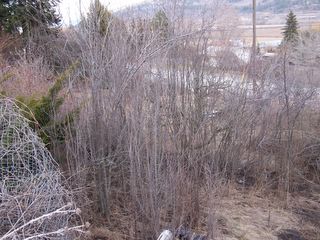Monday, March 20, 2006
Happy Spring!!
I spent part of my day working out in the yard. In the Area Formerly Known as Lawn, I pulled and dug up all the weeds and burdock plants, stacking them into piles to be disposed of as soon as possible. I then dug up several small lilac bushes from the base of the mother bush, being careful to keep the roots as intact as possible so I can plant them again in other places in my yard. I think I'll plant them along the highway side of the property, that will look nice when eventually there is a large hedge there. I still have more little lilacs to dig up and move, as well as dirt to move around and flatten out in this area, but it feels great to have gotten a good chunk of work done today.
Saturday, March 18, 2006
Research: Mulch
Here are some Mulch Sites I found interesting:
http://www.compost.org/mulchingPR.html
http://www.ces.ncsu.edu/depts/hort/consumer/factsheets/trees-new/text/muching.html
http://www.ciwmb.ca.gov/Publications/Organics/44302010.pdf
http://hgic.clemson.edu/factsheets/HGIC1604.htm
http://en.wikipedia.org/wiki/Mulch
You can copy these and paste them into your browser, or you can also Google "mulch" for these and more links.
Wednesday, March 15, 2006
Tire Planters
http://suite101.com/files/topics/75/files/felderstireplanter.html ...I found this link through the Pathway to Freedom web page. There is a page there that gives links to lots of DIY sites:
http://www.pathtofreedom.com/diy/index.shtml
In the past I've used tires for planting flowers or tomatos in, but I just stuffed dirt/soil inside the tire, then filled the hole with dirt and did my planting. It worked well enough, but still looked like a tire laying on the ground with a plant in it, and when the plants are dead it just looks like a tire cluttering up the yard. The ones at the above site are much fancier, haha.
Wildside also mentioned using the tires for growing tomatoes... I'm not sure how to do that. I can give it a good guess and I think I'd come pretty close, who knows, lol... maybe Wildside will share some info in a future comment.
I have also heard of using tires for planting potatoes. You plant the seed potatoe in the soil in a tire. When it grows you add a tire on and fill it with more soil, leaving just a small amount of the stalk sticking out. Then when it grows more you add another tire, etc. I guess you just keep doing this as long as it grows, or maybe until the stack gets too high for you to add another (if you're short this may not take too long). Anyway, the "spuds" grow in the dirt inside the tires as they would in the ground. To harvest potatoes from the ground you of course have to dig them up, but with the tires you just remove a tire and brush away the soil every time you want more spuds, then at the end of the season you remove all tires and soil and get your crop. Pretty cool, huh. "New" potatoes... mmmm, with fresh from the vine tomatoes. Thank God summer will soon be here. I'm looking forward to the proceeds of my first garden.
So far we have a tire retaining wall and different tire planters... anyone have any other ideas for using old tires? Get your "recycling mind" moving and share your ideas in the comments section!
Wednesday, March 08, 2006
Main Theme
I posted to Freecycle that I need fence posts and one man was good enough to email me that he has around 15, give or take a few, that I can have. Tomorrow (umm, errr, later today, it's after midnight here) I will pick them up and bring them home. That is a good start on what I'll need in order to fence the whole place... guess one thing I should do is measure the area and figure out the total number of posts I do need. If you are wondering what Freecycle is, or if you want to give away or get "stuff" all for free, check it out, there's one in your area too... www.freecycle.org
Tuesday, March 07, 2006
More Pictures
Comments
You can go see comments posted to my blog by following the comments links, and also leave comments there if you like. I am copy/pasting Kiwi's comment here from her post on PTF because it was so nice.
Kiwi said:
I wanted to leave a comment on your blog,
Just wanted to suggest that you focus on only one small area at a time. I have found that when the task is large it is very easy to be overwhelmed by all that is required...and then end up achieving nothing! (I am good at that!)
You have a good attitude and are obviously well motivated, so I'm sure you will soon notice those yard improvements.
Some suggestions....I am a list person, so would draw up a task list before starting. Then gradually work through that list...maybe starting with clearing the stuff that you mentioned that needs to be dumped.
Maybe you could have what we (in
It's just a pity that the whole PTF e-neighbours "gang" cannot come around to lend a hand! What an event that would be! I suspect we'd all start talking and laughing and never quite get to the work!
Thanks for sharing your thoughts and your blog.
Monday, March 06, 2006

#28 - White shed has been everything from storage to rabbit shelter, currently needs cleaning out and mouse proofing so it can be used again. The lean-to was built as a rabbit shelter but when I went out of raising and showing rabbits, this became a chicken house. You go through the blue door into the chicken run, then through the storm door into the lean-to. I'll be happy when I can finally give the chickens a bigger, better run on the hill and remove this one.


#26 - I've been digging a few times this February when days were nice enough to work outside. I've dug up from the concrete blocks {rabbit manure pit from when I raised rabbits} to where you see the shovel by the chain link fence. I leave a trench each time I dig, but the chickens soon cover it in with their scratching around. They love the freshly dug dirt.

The Area Formerly Known as Lawn
One fall my septic line plugged and backed up, flooding my bathroom. I was told it was probably a full septic tank so have it pumped out... but where is it? A "Bobcat" was brought in and dug a trench about 60' long by 5-6' deep, and found not even a sign of a pipe or anything. I had to fill this all in with a shovel, and this pretty much destroyed a large part of the lawn.
While waiting for me to find more financing before they came back to dig more in another area, I talked to a lady I knew that has Spririt Guides. Tricia had never been to my home, had no idea where I live, but consulted her Guides and told me exactly where the septic tank is. I had the Bobcat driver dig where Tricia said and they found it. Unfortunately, it's underneath the tire retaining wall I mentioned earlier. Thankfully, at both ends of the 6'+ area of the wall, there are parts only 3'+ high and it was under the southern most 3'+ end of the wall. This was bad enough as due to the digging that part of the wall collapsed and I don't really know what to do about it.
After the tank was pumped, this guy tells me there's gravel in the septic tank, showing him that the line from toilet to tank is broken. A plumber ran a snake down the line and found it was plugged with some kind of roots, so yes, it was a broken line. Back came the Bobcat and dug up a bunch from the tank towards the house until the broken part was uncovered. This further destroyed both the tire retaining wall and the lawn, but the line was fixed and after about 2 months I finally could use my toilet and washing machine again, have baths, etc.
About 2 years later the septic again backed up and flooded the bathroom. This time it was again found that the line was broken, so back comes the Bobcat and digs up from the previous repair to the outside wall of the house, and replaced that part of the line. He assured me I'd be okay now.
Within a year or two "here we go again". This time the break was underneath the house itself. Back with the Bobcat, dug up the yard again to put in a "clean out line" from the existing line {which is about 5' deep at the outside wall of the mobile, dropping deeper from there} to just above the ground. Then a new line had to be put in from the toilet to join in with the clean out line. So, as of Fall 2004, the line from toilet to tank has all been replaced, so surely I won't have any more problems with this for many years to come.
Even though it should be okay now, I don't feel comfortable with the idea of covering up this area with anything permanent. It will have to be done in such a way that if ever it has to be dug up again, things will be easy to move and to replace to again make it look nice. For this reason, I am thinking everything in this area should be in pots or movable planters.
Now you know the sad sagga of The Area Formerly Known as Lawn




